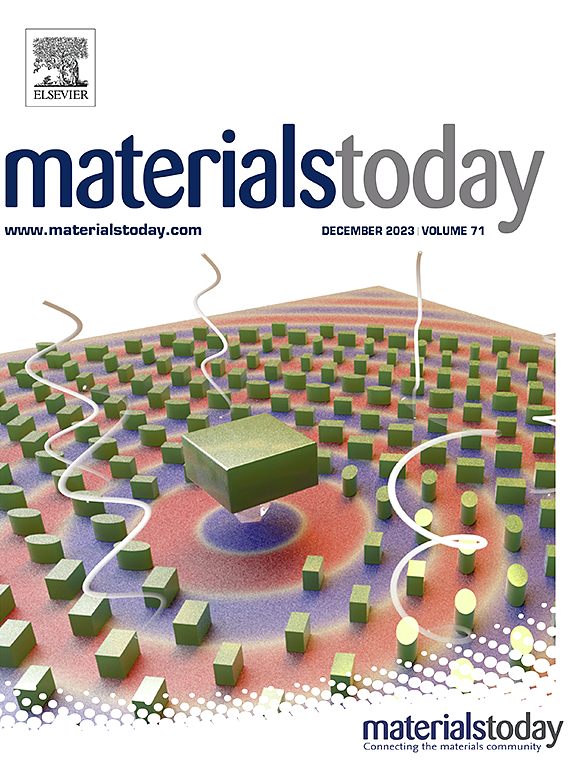New block copolymers to form nanofibers with superior mechanical properties and to conjugate signaling molecules directing tissue regeneration
IF 22
1区 材料科学
Q1 MATERIALS SCIENCE, MULTIDISCIPLINARY
引用次数: 0
Abstract
Tissue engineering is a multidisciplinary field grown rapidly over the past few decades, whose success most often requires bioactive scaffolds to structurally support and biologically direct cell fate and tissue regeneration. Poly(l-lactic acid) (PLLA) is a widely used tissue engineering material with high strength, biocompatibility, biodegradability, and the capability of nanofiber formation through thermally induced phase separation (TIPS). To enable biomolecule conjugation, a new PLLA-based block copolymer, poly(spiro-lactic-co-lactic acid)-block-poly(l-lactic acid) or PSLA-b-PLLA, was developed in this study. The new polymer PSLA-b-PLLA could also form nanofibers through TIPS, and excitingly greatly improved the mechanical properties over PLLA nanofibers, with up to 1.2 times tensile modulus, 12.1 times strain at break, 2.1 times ultimate strength and 35.1 times toughness of PLLA, while being able to conjugate bioactive molecules covalently using click reactions. Its degradation rate was also accelerated to facilitate tissue regeneration. The tissue engineering potential of the new polymer scaffold was evaluated using a mouse critical-sized bone regeneration model, showing 3.6 times more vascularized bone volume regeneration when covalently conjugated with a bone-morphogenetic-protein-2-derived peptide. The block copolymer satisfies multiple criteria for tissue engineering with tunable mechanical properties, degradation rate, and conjugation densities. It can be utilized to impart specific biomolecular signals and mechanical properties potentially for various other tissue engineering applications.

新型嵌段共聚物可形成具有优异机械性能的纳米纤维,并可偶联引导组织再生的信号分子
组织工程是近几十年来快速发展的多学科领域,其成功通常需要生物活性支架在结构上支持和生物上指导细胞命运和组织再生。聚乳酸(PLLA)是一种广泛应用的组织工程材料,具有高强度、生物相容性、可生物降解性以及通过热诱导相分离(TIPS)形成纳米纤维的能力。为了实现生物分子的偶联,本研究开发了一种新的基于聚乳酸的嵌段共聚物,聚(螺-乳酸-共乳酸)-嵌段聚(l-乳酸)或PSLA-b-PLLA。新型聚合物PSLA-b-PLLA还可以通过TIPS形成纳米纤维,其力学性能比PLLA纳米纤维提高了1.2倍的拉伸模量,12.1倍的断裂应变,2.1倍的极限强度和35.1倍的韧性,同时能够通过点击反应共价共轭生物活性分子。其降解速度加快,有利于组织再生。使用小鼠临界尺寸骨再生模型评估了新聚合物支架的组织工程潜力,当与骨形态发生蛋白-2衍生肽共价结合时,血管化骨体积再生增加3.6倍。嵌段共聚物满足组织工程的多种标准,具有可调的机械性能、降解率和共轭密度。它可以用来传递特定的生物分子信号和机械性能,潜在地用于各种其他组织工程应用。
本文章由计算机程序翻译,如有差异,请以英文原文为准。
求助全文
约1分钟内获得全文
求助全文
来源期刊

Materials Today
工程技术-材料科学:综合
CiteScore
36.30
自引率
1.20%
发文量
237
审稿时长
23 days
期刊介绍:
Materials Today is the leading journal in the Materials Today family, focusing on the latest and most impactful work in the materials science community. With a reputation for excellence in news and reviews, the journal has now expanded its coverage to include original research and aims to be at the forefront of the field.
We welcome comprehensive articles, short communications, and review articles from established leaders in the rapidly evolving fields of materials science and related disciplines. We strive to provide authors with rigorous peer review, fast publication, and maximum exposure for their work. While we only accept the most significant manuscripts, our speedy evaluation process ensures that there are no unnecessary publication delays.
 求助内容:
求助内容: 应助结果提醒方式:
应助结果提醒方式:


